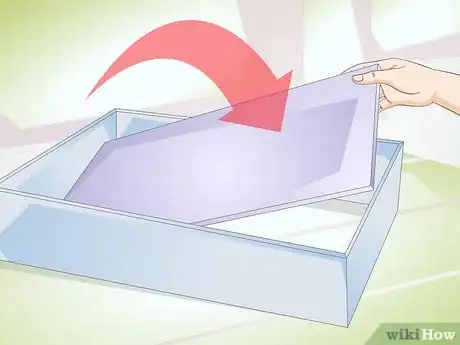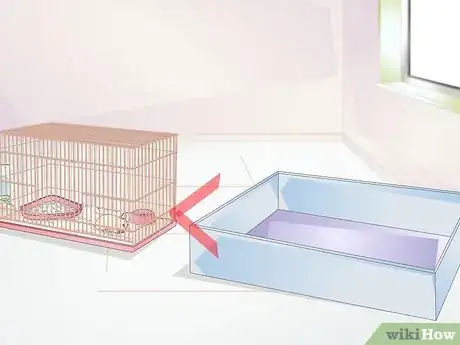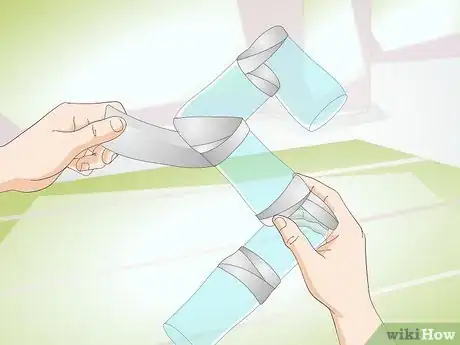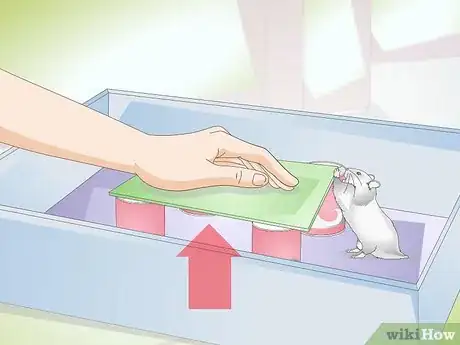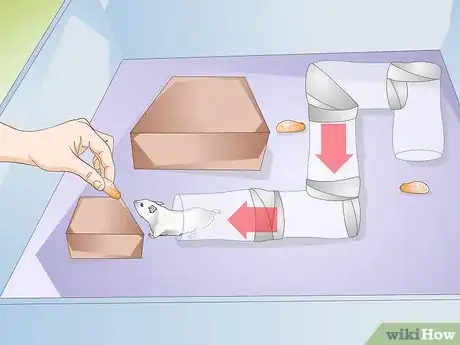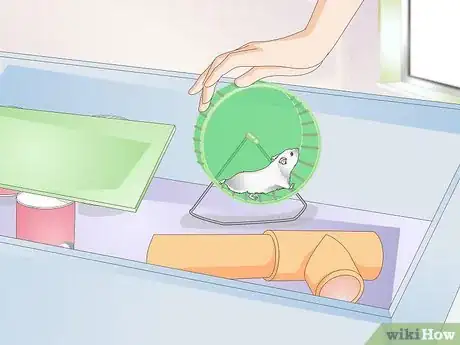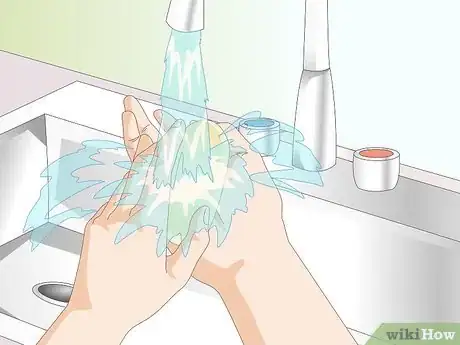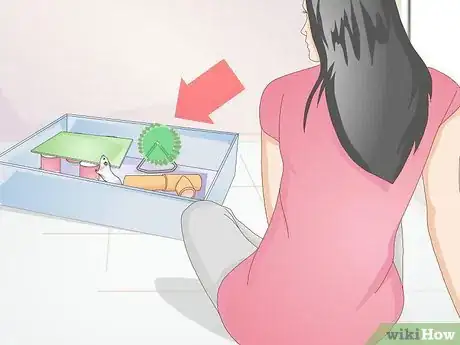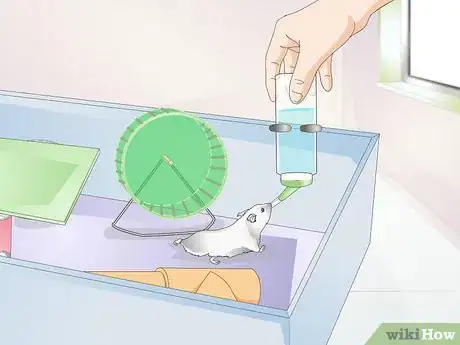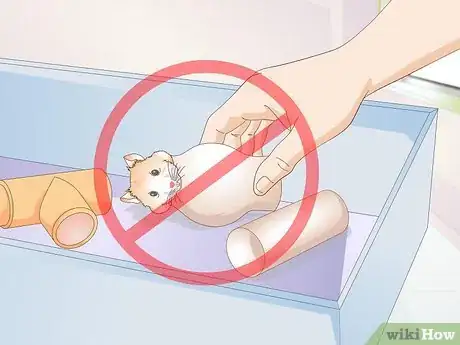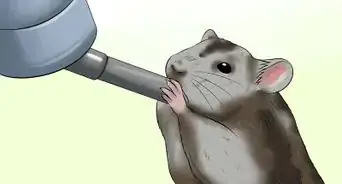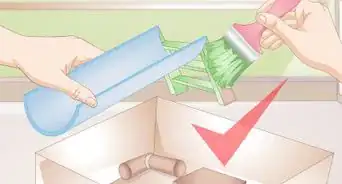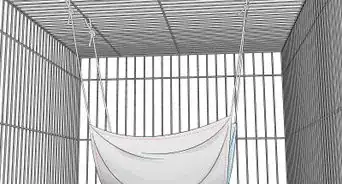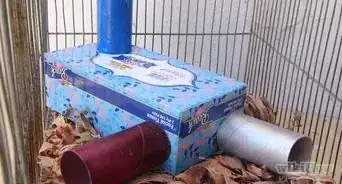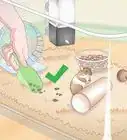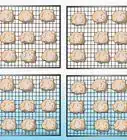This article was co-authored by Pippa Elliott, MRCVS. Dr. Elliott, BVMS, MRCVS is a veterinarian with over 30 years of experience in veterinary surgery and companion animal practice. She graduated from the University of Glasgow in 1987 with a degree in veterinary medicine and surgery. She has worked at the same animal clinic in her hometown for over 20 years.
This article has been viewed 72,538 times.
Small animals that normally live in cages love the opportunity to get out of their cages to explore and play. Hamsters are normally very active and while their cages may have lots of toys, they also need a bigger space once in a while to explore and have fun. Because the world is dangerous for a hamster, building him a playpen where he can explore in safety is a great idea.[1]
Steps
Building the Playpen Structure
-
1Build the walls of the playpen with something slippery. A playpen needs to be a safe place for your hamster to explore, so it shouldn't be made of materials a hamster can climb or chew. Corrugated plastic is a great option as it is not only slippery, it can easily be cut to any size you need. Another great option is a large Rubbermaid-type container with tall sides.[2]
- You can attach pieces of plastic together with anything from binder clips to duct tape.
- Plastic is also really easy to clean and is unlikely to stain.
- If you decide to use a Rubbermaid-type container for a playpen, never put the lid on the container while your hamster is inside unless you’ve provided proper ventilation.
-
2Decide if you want to build the playpen with a bottom. Your hamster’s playpen can either just have walls, or you can also build a bottom. If you’re able to place the playpen on a tile or wood floor, you may not need a bottom as the floor may be easy to clean. If you’re going to put the playpen on a carpet, you may want to include a bottom.[3]
- A bottom is also useful as the playpen will be much easier to pick-up and move while keeping all the toys inside.
- Each item inside the playpen would have to be moved separately if you build a playpen with no bottom or floor.
Advertisement -
3Determine the size of the playpen you want. Ideally, your hamster’s playpen should be bigger than his cage. But, it will also need to fit somewhere in your home on the floor. Plus, you will need to store your hamster’s playpen when he isn’t using it. Take all of these things into consideration when deciding how large you want the playpen to be. In the end, it doesn’t matter how big or small it is, as long as it works for you and your hamster.
-
4Use large boxes as a temporary playpen. If you want to give your hamster a place to explore, but you need time to collect the proper materials to build a more permanent playpen, consider using a large box for the time being. A box that a large item was pack in would work best, such as a TV, printer, toaster oven, microwave, etc.[4]
- A box won’t be able to be a permanent playpen because your hamster will likely chew through eventually.
- Plus, if your hamster pees inside the box, you won’t be able to clean it up.
- Consider placing a large plastic bag or garbage bag under the box to help protect your floor.
-
5Connect empty plastic bottles together to build a hamster maze. A hamster maze can be built for use inside your hamster’s playpen, cage, or even on its own. While there are many commercially available hamster maze pieces available at the pet store, you can also build your own using an empty plastic bottle (e.g. water bottles, pop bottles, juice bottles, etc.)
- Make sure to completely wash and dry the bottles before using them to make a maze.
- You will need to cut either the top, bottom, or edges of the plastic bottles, depending on the design of your maze. Cutting the plastic will create sharp edges that can injure your hamster. Use duct or electrical tape around the sharp edges to blunt them and make them safe.
- Use the same tape to connect multiple bottles together. You can connect the bottles end-to-end, or cut a hole in the side of one bottle so a second bottle can be attached at a 90-degree angle.
Adding Enrichment Items to the Playpen
-
1Add multiple levels to the playpen. Use smaller boxes, cans, tins, and anything else you can find that your hamster can climb up and down on. This will provide your hamster with multiple levels within his playpen to explore. You can even get creative and attach these items together in such a way that you create a maze for your hamster to find his way through.[5]
- Make sure your playpen has at least one place where your hamster can hide while he’s in the playpen. Having a place to hide will make your hamster feel safe if he gets nervous or scared.
- A great place to look for homemade items is your recycling bin. Just make sure to thoroughly clean any items you decide to use. And make sure to blunt sharp edges with tape or padding.
-
2Include play stations for your hamster to explore. The purpose of the playpen is so that your hamster has a larger area to run around and play. While some hamsters may be happy with a big open space, adding additional items to the playpen will give your hamster some much-needed enrichment. Place items such as the following inside the playpen for your hamster to play with:[6]
- Toilet paper or paper towel tubes. You can attach multiple tubes together to create a long tunnel.
- Old shoes. Your hamster will enjoy climbing in and out of the shoe and using it as a hiding place.
- Bridges, see-saws, and swings. You can make your own, or buy hamster-specific versions at the pet store.
- Wooden, mineral, or salt blocks. While your hamster may climb these blocks, the real purpose is to give your hamster something to chew on.
-
3Create food puzzles for the playpen. Use boxes and toys from your hamster’s playpen to make a food puzzle. Combine multiple items together in such a way that your hamster has to explore them to find a treat. You can also build a maze with a food treat at the end.[7]
- Make sure any food you give your hamster inside his playpen is deducted from his daily food allocation. If you give your hamster extra food and treats while he’s in his playpen, your hamster may get a little pudgy.
-
4Place a free-standing wheel inside the playpen. Even if your hamster has a wheel in his cage, placing a freestanding wheel inside his playpen will give him another view while he runs. Make sure the wheel is made from a continuous piece of material and not wires or bars. Wheels made from wires or bars can cause your hamster to get one or both of his feet stuck and could cause serious injury.[8]
-
5Put your hamster in a hamster ball. Hamster balls are a great way for your hamster to explore the big world outside his cage without getting lost or stuck. Hamster balls are usually large hard plastic balls with a hatch that can open and close so you can place your hamster inside. Once the hatch is closed, the outside of the ball is smooth so it can roll in any direction. If you don’t have an area within your home that’s safe for your hamster to explore in his hamster ball, consider making a large playpen and placing the hamster ball inside.
- Using a combination of a playpen and a hamster ball will limit the area your hamster can explore, thus making it safer for your hamster and more convenient for you.
- Keep your hamster’s time in a hamster ball to 15 minutes or less. Once he’s finished with his hamster ball, put him back in his cage for a rest.
Giving Your Hamster Some Playtime
-
1Wash your hands before and after your play with your hamster. Before you go to take your hamster out of his cage and place him in his playpen, wash and dry your hands. If you’re going to do something else while your hamster is in his playpen, make sure to wash your hands again before touching other items. When putting your hamster back into his cage, again, wash your hands before and after handling your hamster.[9]
- Hamsters can have ‘accidents’ while in your hands, or climbing around their playpens, so it’s a good idea to always wash your hands before you do anything else.
- Hamsters also have a really great sense of smell, but very poor eyesight. If they smell food on your hands and fingers, they may bite you thinking it is food. Washing the smell of food of your hands before touching your hamster can save you from dealing with painful bites.
-
2Supervise your hamster while he’s in his playpen. While a quick visit to the bathroom or the kitchen should be okay, you shouldn’t leave your hamster alone in his playpen unsupervised. Your hamster made need your assistance if he ever gets stuck or if he manages to escape.[10]
- It would also be helpful to close any doors to the room where you’ve placed your hamster’s playpen, just in case he does manage to escape. If the doors are closed, you’ll have a much smaller space to search for your hamster.
-
3Provide water for your hamster in his playpen. Even if your hamster is only going to be in his playpen for a short period of time, it’s always a good idea to include a small water bowl just in case he gets thirsty. This may be even more important if you’re giving him dry treats or kibble inside the playpen.[11]
- Hamster water bottles that hang on the side of a cage may not work in a playpen. Instead, just use a small bowl of water that your hamster can easily reach.
-
4Be careful when using toilet paper or paper towel tubes. As long as you supervise your hamster, he should be just fine. But if he’s a Syrian hamster who is a little plump, you may want to avoid giving him any tunneling materials like toilet paper or paper towel tubes. Unfortunately, your hamster may misjudge his own size and get himself stuck inside one of these tubes![12]
- If he does get stuck, gently help him get out of the tube using just your hands. Don’t use any sharp objects to cut the cardboard while your hamster is inside.
Warnings
- Do not leave your hamster unattended or unsupervised inside the playpen. Hamsters are great escape artists and no matter how well you build the playpen, there’s always a chance a hamster will find a way to get out.[13]⧼thumbs_response⧽
- If you decide to make enrichment items from something like cans or cut plastic, make sure to either remove sharp edges or cover them with something to protect your hamster from being injured.[14]⧼thumbs_response⧽
References
- ↑ http://animals.mom.me/build-hamster-playpen-9731.html
- ↑ http://animals.mom.me/build-hamster-playpen-9731.html
- ↑ http://animals.mom.me/build-hamster-playpen-9731.html
- ↑ http://animals.mom.me/build-hamster-playpen-9731.html
- ↑ http://animals.mom.me/build-hamster-playpen-9731.html
- ↑ http://animals.mom.me/build-hamster-playpen-9731.html
- ↑ http://animals.mom.me/build-hamster-playpen-9731.html
- ↑ http://animals.mom.me/build-hamster-playpen-9731.html
- ↑ http://www.nessexotic.com/docs/Hamsters.pdf
About This Article
To make a hamster playpen, use a large, sturdy box, or tape pieces of cardboard or plastic together in a square shape, and add a bottom if you want. Just make sure the playpen is tall enough that your hamster can’t climb over the walls. Add objects to the playpen that your hamster can climb in, around, and under, like smaller boxes, cans, and toilet paper tubes. You can also place blocks made from wood or salt in the playpen to give your hamster something to chew on while it plays! Keep reading to learn tips from our veterinary reviewer how to build a hamster maze out of empty bottles!

